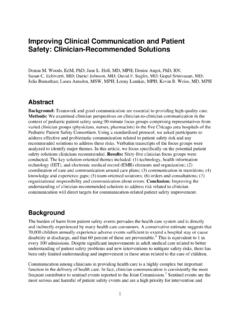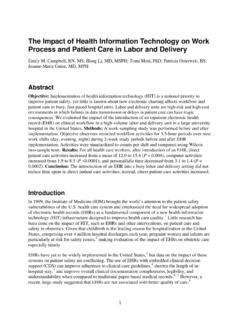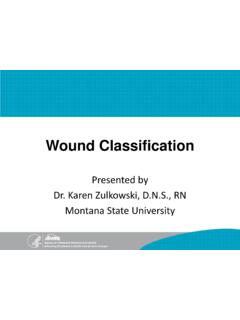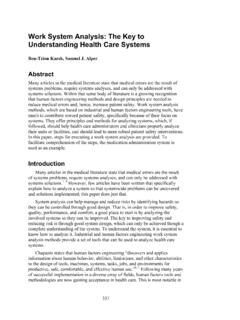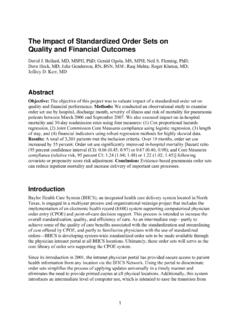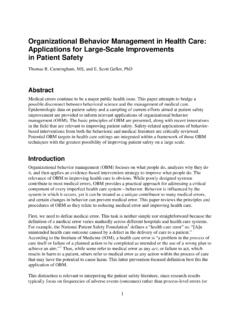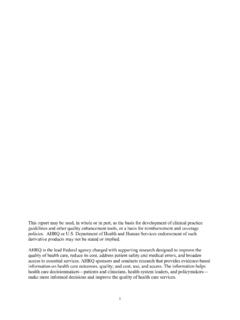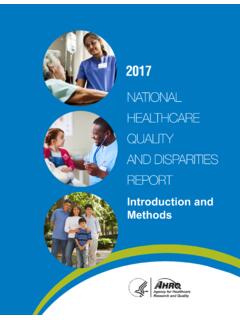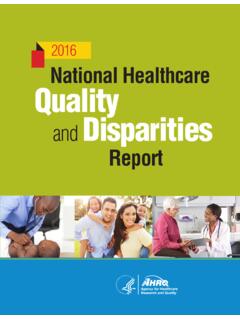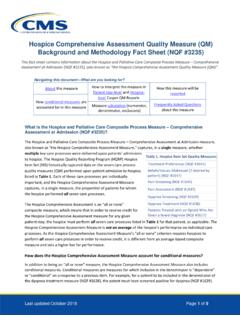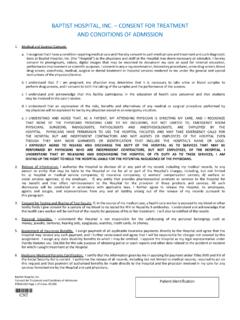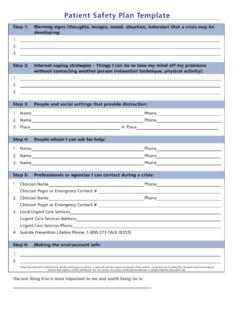Transcription of Hospital Survey on Patient Safety Culture: User's Guide
1 P ITA L. HOS. SU RV E Y. ON. PA T IE N T. SA F E TY. LTU RE. CU. R ' S G UIDE. USE. Patient . Safety . AHRQ Hospital Survey on Patient Safety culture : User's Guide Prepared for: Agency for Healthcare Research and Quality Department of Health and Human Services 540 Gaither Road Rockville, MD 20850. Contract No. HHSA290201300003C. Prepared by: Westat, Rockville, MD. Joann Sorra, Laura Gray, Suzanne Streagle, Theresa Famolaro, Naomi Yount, Jessica Behm, AHRQ Publication No. 18-0036-EF. Replaces 04-0041, 15(16)-0049-EF. July 2018. This report may be used, in whole or in part, as the basis for development of clinical practice guidelines and other quality enhancement tools, or a basis for reimbursement and coverage policies. AHRQ or Department of Health and Human Services endorsement of such derivative products may not be stated or implied. AHRQ is the lead Federal agency charged with supporting research designed to improve the quality of health care, reduce its cost, address Patient Safety and medical errors, and broaden access to essential services.
2 AHRQ sponsors and conducts research that provides evidence- based information on health care outcomes; quality; and cost, use, and access. The information helps health care decisionmakers patients and clinicians, health system leaders, and policymakers make more informed decisions and improve the quality of health care services. This document is in the public domain and may be used and reprinted without permission except those copyrighted materials noted for which further reproduction is prohibited without the specific permission of the copyright holders. Citation of the source is appreciated. Suggested Citation: Sorra J, Gray L, Streagle S, et al. AHRQ Hospital Survey on Patient Safety culture : User's Guide . (Prepared by Westat, under Contract No. HHSA290201300003C). AHRQ Publication No. 18-0036-EF (Replaces 04-0041, 15(16)-0049-EF). Rockville, MD: Agency for Healthcare Research and Quality. July 2018.
3 Patient - Safety /patientsafetyculture/ ii Contents of This Survey User's Guide The AHRQ Hospital Survey on Patient Safety culture , this User's Guide , and other toolkit materials are available on the AHRQ Web site ( Safety / ). These materials are designed to provide hospitals with the basic knowledge and tools needed to conduct a Patient Safety culture assessment, along with ideas for using the data. This Guide provides a general overview of the issues and major decisions involved in conducting a Survey and reporting the results. Part One: Survey User's Guide Chapter 1. Introduction ..1. Development of the Hospital Survey on Patient Safety culture ..1. Patient Safety culture Composites ..3. Modifications to the Survey ..4. Chapter 2. Getting Determine Available Resources and Project Scope ..5. Decide on Your Data Collection Decide Whether To Use Survey Identifiers ..6. Decide Whether To Use an Outside Vendor.
4 7. Plan Your Project Schedule ..7. Form a Project Team ..9. Establish Points of Contact Within the Hospital ..9. Chapter 3. Selecting Your Survey Population ..11. Determine Whether To Conduct a Census or Sample ..11. Determine Whom To Survey ..11. Determine Your Sample Size ..12. Compile Your Sample List ..12. Review and Fine-Tune Your Sample ..13. Chapter 4. Paper Surveys ..15. Distributing Surveys ..15. Returning Surveys ..15. Publicizing and Promoting the Following Survey Administration Steps ..16. Developing and Assembling Survey Materials ..17. Chapter 5. Web-Only and Mixed-Mode Surveys ..20. Publicize and Promote the Survey ..20. Following Survey Administration Steps ..20. Develop Survey -Related Materials ..22. Design and Pretest Web Surveys ..24. Chapter 6. Analyzing Data and Producing Reports ..27. Identify Incomplete and Ineligible Surveys ..27. Calculate the Final Response Rate ..27.
5 Edit the Data and Prepare the Data File ..27. Analyze the Data and Produce Reports of the Results ..29. Technical Assistance ..32. References ..32. iii Hospital Survey on Patient Safety culture : Composites and Items ..40. Appendix A. Sample Data Collection Protocol for the Hospital Point of Contact: Paper Survey ..43. Appendix B. Sample Data Collection Protocol for the Hospital Point of Contact: Web Survey ..44. Appendix C. Sample Data Collection Protocol for the Hospital Point of Contact: Mixed-Mode Survey ..45. List of Figures Figure 1. Task Timeline for Project Planning for a Single Hospital ..8. List of Tables Table 1. Patient Safety culture Composites and Definitions ..3. Table 2. Minimum Sample Sizes by Numbers of Physicians and Staff ..12. Table 3. Example of How To Compute Frequency Percentages ..30. Table 4. Example of How To Calculate Item and Composite Percent Positive iv Chapter 1.
6 Introduction As hospitals continually strive to improve Patient Safety and quality, Hospital leadership increasingly recognizes the importance of establishing a culture of Safety . Achieving such a culture requires leadership, physicians, and staff to understand their organizational values, beliefs, and norms about what is important and what attitudes and behaviors are expected and appropriate. A definition of Safety culture applicable to all health care settings is provided below. Safety culture Definition The Safety culture of an organization is the product of individual and group values, attitudes, perceptions, competencies, and patterns of behavior that determine the commitment to, and the style and proficiency of, an organization's health and Safety management. Organizations with a positive Safety culture are characterized by communications founded on mutual trust, by shared perceptions of the importance of Safety , and by confidence in the efficacy of preventive measures.
7 Study Group on Human Factors. Organising for Safety : third report of the ACSNI (Advisory Committee on the Safety of Nuclear Installations). Sudbury, England: HSE Books; 1993. Development of the Hospital Survey on Patient Safety culture Purpose The Agency for Healthcare Research and Quality (AHRQ) and Medical Errors Workgroup of the Quality Interagency Coordination Task Force (QuIC) sponsored the development of the Hospital Survey on Patient Safety culture . The Hospital Survey is designed specifically for Hospital staff and asks for their opinions about the culture of Patient Safety at their hospitals. The Survey can be used to: Raise staff awareness about Patient Safety , Assess the current status of Patient Safety culture , Identify strengths and areas for Patient Safety culture improvement, Examine trends in Patient Safety culture change over time, Evaluate the cultural impact of Patient Safety initiatives and interventions, and Conduct comparisons within and across organizations.
8 Survey Development and Pilot Test Under contract to AHRQ, a Survey design team from Westat conducted the following activities to identify key composites of Hospital Safety culture , relevant background questions about staff and Hospital characteristics, and appropriate terms and words to use in the Survey : Reviewed the literature, including existing surveys, pertaining to Patient Safety , Hospital medical errors and quality-related events, error reporting, Safety climate and culture , and organizational climate and culture . 1. Conducted background interviews with experts in the field of Patient Safety and with Hospital staff. Based on these activities, the design team developed draft Survey items to measure the identified key composites and conducted cognitive interviews with Hospital staff. Cognitive interview participants included clinical staff, such as physicians, nurses, and other allied health professionals, and nonclinical staff, including administrators and unit clerks.
9 The design team also received input on the draft Survey from the Joint Commission, additional Patient Safety researchers, Hospital systems administration, and professional associations. The draft Survey was pilot tested with more than 1,400 Hospital employees from 21 hospitals across the United States. The design team examined the reliability and factor structure of the Patient Safety culture composites. Based on these analyses, the final items and composites in the Hospital Survey on Patient Safety culture were determined to have sound psychometric properties (Sorra and Nieva, 2003). Hospital Definition The purpose of the Hospital Survey on Patient Safety culture is to measure the culture of Patient Safety at a single Hospital in a specific location. We therefore consider each unique facility to be a separate site for the purposes of Survey administration and providing Hospital -specific feedback.
10 When you administer the Survey at multiple hospitals, you should identify each Hospital as a separate site so that each site can receive its own results in addition to overall results across sites. We also recommend that there be at least 10 respondents from a Hospital for a Survey feedback report to be provided to the site, to protect respondent anonymity. Hospitals that are part of a health system can have their data aggregated with others for feedback purposes. Identification of Survey Participants The Survey examines Patient Safety culture from a Hospital staff perspective. All staff asked to complete the Survey should have enough knowledge about your Hospital and its operations to provide informed answers to the Survey questions. Overall, when considering who should complete the Survey , ask yourself: Does this person know about day-to-day activities in this Hospital ? Does this person interact regularly with staff working in this Hospital ?
